Regular sweeping keeps resin-bound gravel free from debris and moss. Clean monthly with warm water at low pressure, steering clear of harsh cleaning products. Check drainage and gradients each month to ensure proper water runoff.
To prevent UV damage, use protective additives and fix any cracks straightaway with matching resin. Keep the surface slip-resistant by promptly cleaning spillages and using pet-safe de-icer during frosty weather.
For example, autumn leaves left unswept can lead to stubborn staining, whilst blocked drainage channels may cause waterlogging – both easily avoided with routine maintenance.
These simple steps will maintain your driveway’s appearance and structural integrity for years to come.
Key Takeaways
Best Practices for Resin-Bound Gravel Upkeep
- Give your surface a weekly sweep to stop moss taking hold and keep water draining properly – just like you’d sweep your patio.
- Once a month, wash the surface with warm water using gentle pressure (think garden hose, not jet wash). Skip harsh cleaners as they’ll damage the resin.
- Check drainage points monthly, clearing any muck or leaves. Your surface needs a slight slope – roughly 1cm drop for every 60-80cm length.
- Choose UV-protected resin at installation and keep an eye out for any sun-fading, particularly in exposed areas.
- Stay on top of basic care: wipe up any oil or fuel spills straight away, avoid parking heavy machinery, and sort small problems before they grow bigger.
Regular Sweeping and Debris Removal
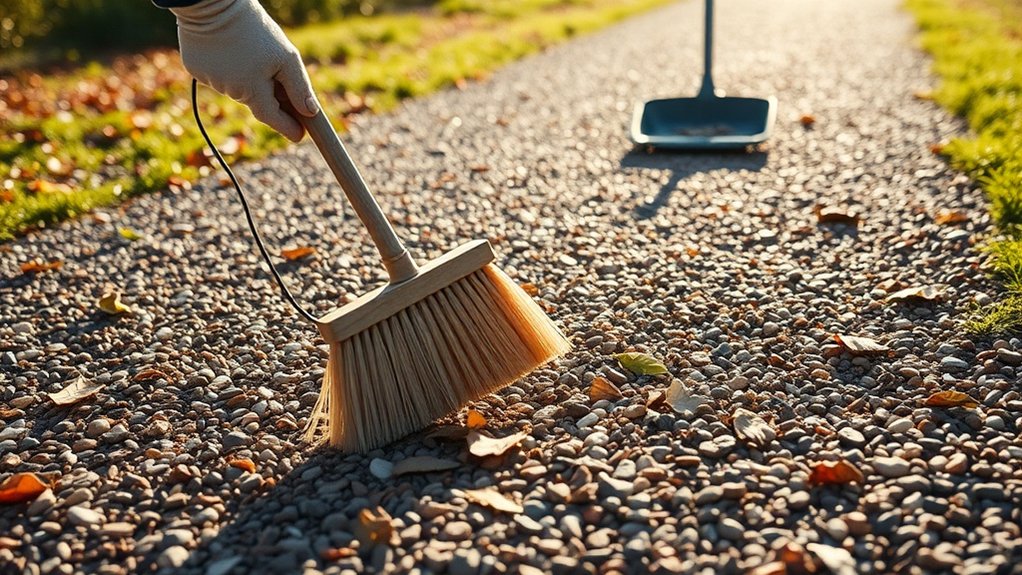
Regular sweeping is vital for maintaining resin-bound gravel surfaces. Sweep at least weekly, particularly during autumn when fallen leaves can cause staining.
Use a stiff-bristled broom or yard brush, but avoid metal brushes as they’ll damage the resin. Work in a back-and-forth pattern to ensure thorough cleaning. It’s essential to remember that regular maintenance can extend the lifespan of resin-bound gravel significantly.
Before sweeping, remove any large bits of debris by hand to prevent surface scratches. Keeping the surface clean not only looks better but also stops moss and algae from taking hold. Regular sweeping helps ensure the surface can maintain its drainage capability in rainy conditions, which is crucial for British weather. It’s especially important to maintain the surface’s drainage capability – regular sweeping ensures water can still pass through effectively, which is crucial for British weather conditions.
Cleaning With Water and Low-Pressure Washing
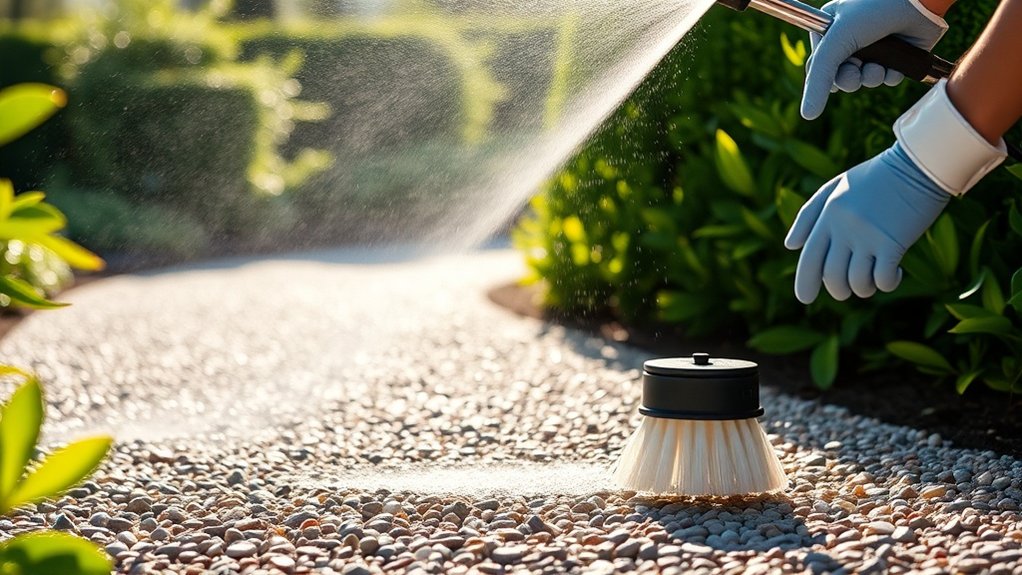
Cleaning resin-bound gravel driveways and paths is straightforward with proper water and low-pressure washing techniques. Use warm water, as cold temperatures could damage the resin. Keep pressure below 150 bar – about the strength of a typical home pressure washer – and fit a flat spray nozzle for even coverage. Holding the nozzle at least 20cm from the surface, work in steady side-to-side movements. For tough marks, washing-up liquid in warm water works well, but ensure thorough rinsing. To maintain the integrity of the surface, regular cleaning is necessary to prevent dirt, oil, and atmospheric pollution. Regular maintenance not only enhances drainage functionality, but also protects the driveway from deterioration. Clean monthly to keep your surface looking its best. Before washing, sweep away leaves and loose dirt. A rotary cleaner attachment, like those used for patios, provides gentle yet thorough cleaning. Skip harsh cleaning products, as they’ll harm the resin binding.
Stain and Moss Prevention

Keeping resin-bound gravel looking fresh means tackling stains and moss head-on. For concrete stains, diluted hydrochloric acid does the job – just remember to rinse well. Mineral marks? Grab some oxalic acid. For those annoying oil patches from your car, a good degreaser will sort it out. Moss can be a real pain, but there’s a simple fix: sweep away leaves and debris regularly, and pop on some water-based moss killer once a year. When you spot moss, use a soft brush to remove it – anything too harsh might damage your surface. Regularly sweeping the surface with a stiff broom will help prevent organic material accumulation that promotes moss growth. Maintaining effective drainage maintenance is crucial, as it prevents standing water that can attract moss. Top tip: check your drainage is working properly. Standing water is a moss magnet, so keeping the surface dry is half the battle. Stick to these basics, and your resin-bound surface will stay looking smart.
Drainage Inspection and Management
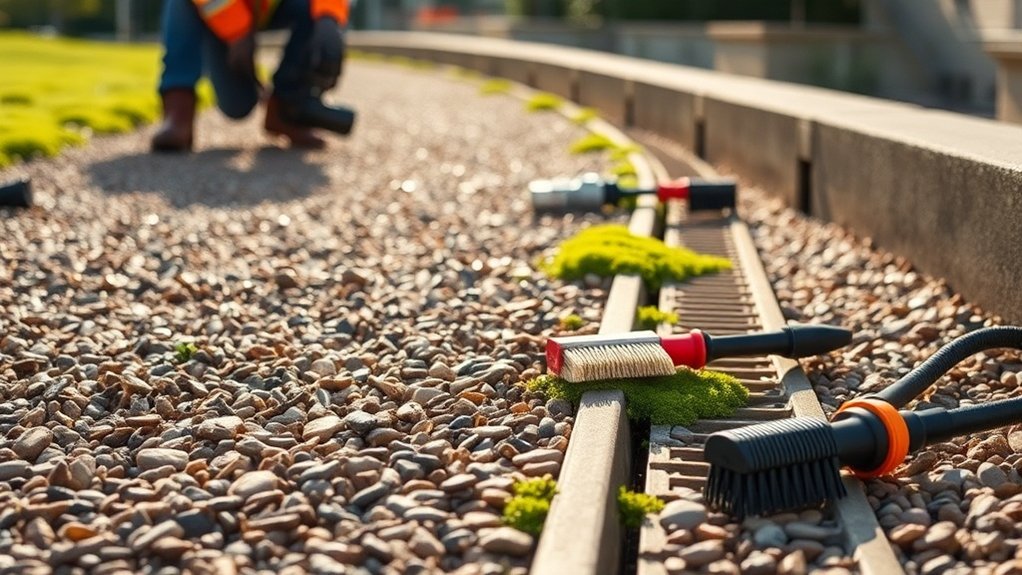
Monthly drainage inspections are essential for your resin-bound surface.
Look for leaves, twigs and dirt that might clog the system, especially during autumn. A blocked drain can lead to standing water and surface damage, particularly after heavy British rainfall.
Simply sweep away debris and check that water drains properly by pouring a bucket of water over different areas. If you spot slow drainage or pooling, it’s best to sort it straight away – waiting could mean costly repairs later on.
Monthly Drainage Checks
Monthly drainage checks for resin-bound surfaces require minimal but consistent attention.
Pour water across different areas of your surface – it should drain away within 60 seconds. After rainfall, look for puddles or standing water, as these suggest drainage problems.
Keep your driveway’s gradient between 1:60 and 1:80 for proper water runoff. Watch for signs of waterlogging or wear that might block drainage channels.
Check that your sub-base remains permeable and in good condition. Regular checks help spot issues early, saving time and money on repairs.
Clear Debris Regularly
Regular debris clearance is vital for resin-bound driveways and paths to maintain proper drainage and prevent damage.
Remove leaves, twigs and garden waste using a stiff brush or leaf blower – avoid pressure washers as they’ll harm the surface.
Check and clear the area in both dry and wet weather, as damp debris encourages moss growth.
Keep an eye on the drainage layer beneath, removing any build-up of soil or grit.
A clean, well-maintained surface will last longer and drain better.
Address Problems Promptly
Keeping your resin-bound gravel driveway in top shape means tackling drainage problems straight away.
Check your surface monthly, particularly after heavy rain or when autumn leaves start falling. A simple garden hose test will show you how water flows, and for tricky spots, use a drainage camera.
If you spot water pooling, act quickly – clear any blockages or add extra drainage where needed. Make sure you sweep away built-up dirt and grit regularly to prevent flooding.
Keep notes of what you find and what you’ve done to sort problems – it’ll help you spot patterns. These basic checks will protect your driveway and keep it looking smart.
UV Protection and Surface Integrity Checks
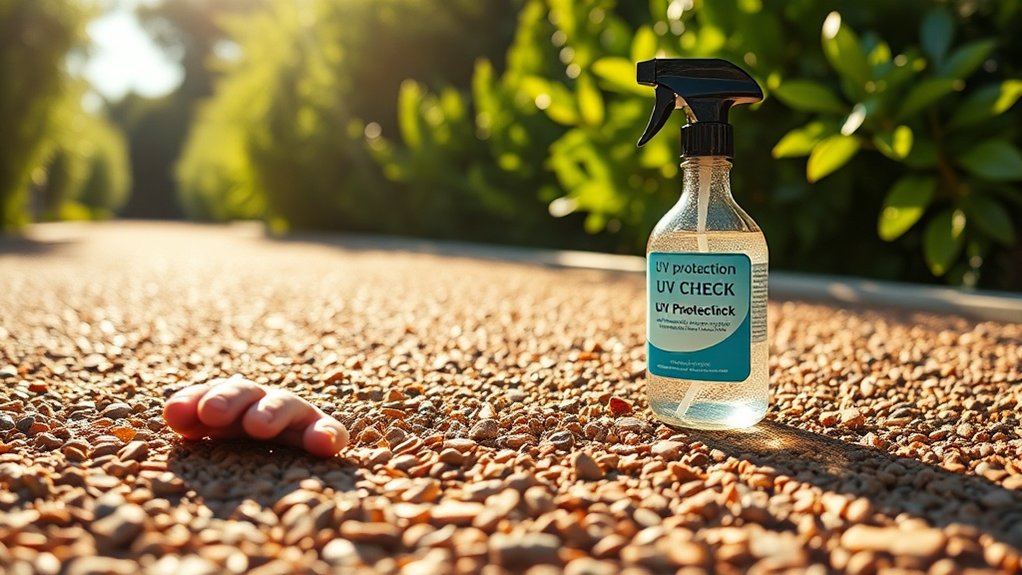
Regular UV exposure poses a significant risk to resin-bound gravel surfaces across the UK. To maintain your surface’s quality, mix UV additives into your resin to prevent fading and yellowing.
Keep an eye out for signs of wear, including colour changes and surface damage. The right resin-to-stone ratio is crucial – too little resin leaves stones loose, whilst too much creates a glossy finish prone to damage.
For British weather conditions, check surfaces after harsh summers and long sunny spells, particularly in exposed areas. Garden furniture can create uneven UV exposure, so try moving items periodically.
If you spot any issues, it’s worth consulting a local specialist, as early intervention often prevents costly repairs.
In heavily exposed areas, such as south-facing driveways, consider using temporary covers during peak summer months. A proper initial installation with quality materials remains your best defence against UV damage and will keep your surface looking smart for years to come.
Winter and Seasonal Care Practices
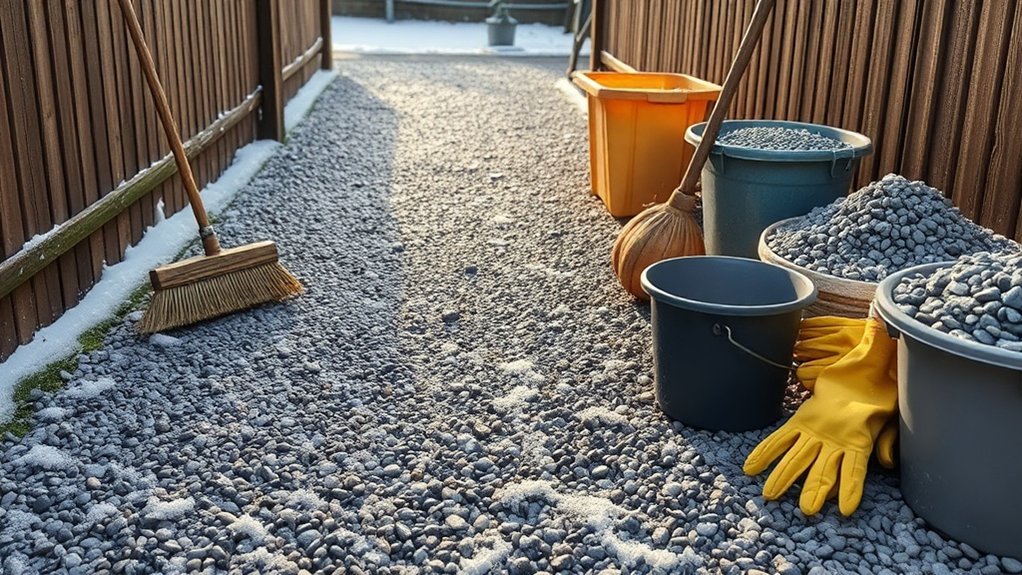
Essential winter care for resin-bound gravel driveways requires proper maintenance to guard against frost, ice and snow damage.
Use plastic shovels and soft brushes rather than metal tools to clear snow, working in layers to prevent heavy build-up.
White rock salt works best for ice management – just remember to sweep away any leftover salt to avoid surface damage.
Keep the area clear of leaves and debris, as trapped moisture can lead to moss.
Check regularly for wear and try to limit heavy vehicles during freezing spells.
These simple steps will help protect your driveway through the British winter months.
Repairing Surface Imperfections
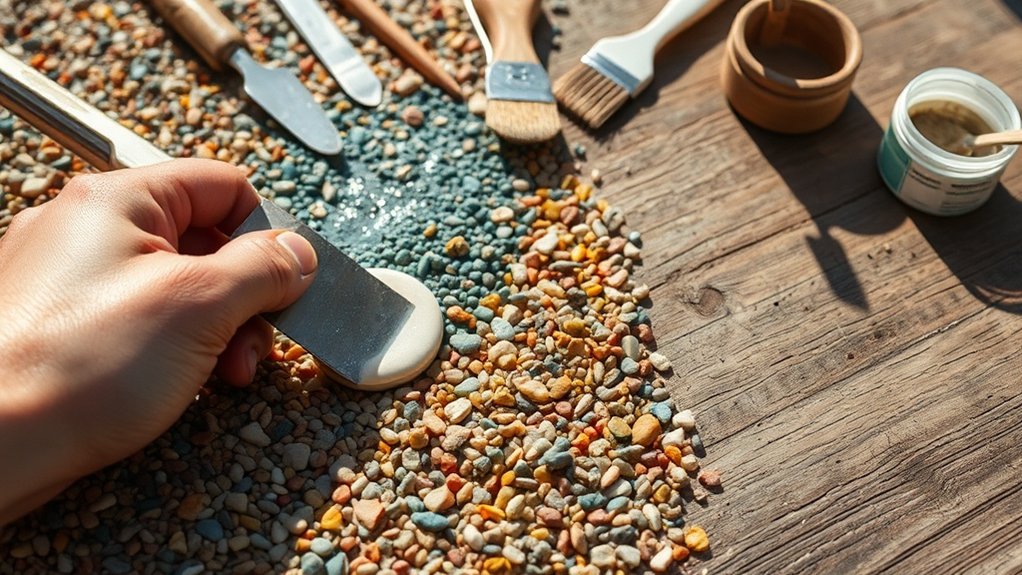
Essential repairs to resin-bound gravel driveways help maintain their looks and function.
First, clean damaged spots with a stiff brush to remove muck and debris, then wash and let dry thoroughly.
For cracks, use a matching resin filler on stable areas to ensure proper bonding.
To match colours, mix spare resin and aggregate in a forced action mixer – much like mixing cake ingredients to get an even consistency.
Press the mixture firmly into holes and cracks to avoid air bubbles.
Check repaired patches sit level with the surrounding driveway surface.
Let repairs cure fully before driving or walking on them – typically 24 hours in dry weather.
These simple steps ensure lasting repairs to your driveway.
Maintaining Anti-Slip Treatments
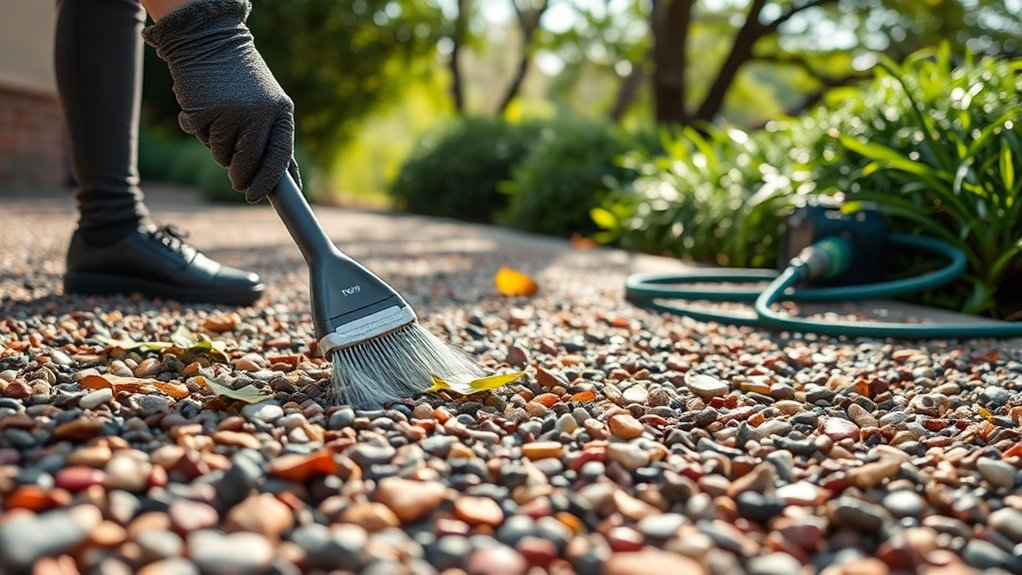
Regular maintenance of anti-slip treatments on resin-bound gravel is vital for safety. Use a stiff brush or leaf blower monthly to remove leaves and debris – this is particularly important when autumn leaves start falling.
A yearly clean with a pressure washer (keep it under 1500 psi) will shift stubborn dirt without harming the non-slip properties.
Watch out during winter months – clear away fallen leaves and ice promptly, and use pet-friendly de-icer rather than salt.
Clean up any spills straight away with gentle cleaning products to protect the resin surface. Keep wheelie bins, heavy garden furniture and sharp objects off the surface to avoid damage to the anti-slip treatment.
Think of it like maintaining grip on trainers – once the sole wears down, you lose traction. The same applies to your resin-bound surface; proper care keeps it safe and slip-resistant.
Frequently Asked Questions
How Long Does Resin-Bound Gravel Typically Last With Proper Maintenance?
A well-maintained resin-bound gravel surface typically lasts 15-25 years in British weather conditions. Quality materials and professional fitting are crucial for durability. Regular checks, prompt cleaning of spillages and periodic resealing (similar to treating a wooden deck) help maximise its lifespan. Think of it like maintaining a car – proper care ensures better performance and longevity.
Can I Install Resin-Bound Gravel Myself, or Should I Hire a Professional?
Whilst DIY installation is possible if you’re experienced with construction work, professional fitting typically yields better results. Specialists have both the proper tools and expertise to lay resin-bound gravel correctly, ensuring proper drainage and a smooth, lasting finish. Think of it like tiling a bathroom – whilst you could do it yourself, a professional tiler will likely achieve a more polished outcome.
What Are the Best Types of Plants to Avoid Near Resin-Bound Surfaces?
Plants to avoid near resin-bound surfaces include any with aggressive root systems or those known to be invasive. Japanese knotweed, bamboo and willow trees are particularly problematic for UK gardens. Choose drought-tolerant plants like lavender, ornamental grasses or Mediterranean herbs instead – these produce minimal debris and won’t compromise your resin surface’s structure.
Is Resin-Bound Gravel Suitable for Heavy Vehicle Traffic Areas?
Resin-bound gravel can handle heavy vehicle traffic quite well, from motorbikes to lorries. It’s strong enough for most domestic and commercial vehicles, though best not to park particularly heavy vehicles, like large HGVs, in one spot for too long as this might stress the surface.
How Does Temperature Affect the Curing Process of Resin-Bound Gravel?
Temperature plays a vital role in how resin-bound gravel sets. In typical British weather, cold conditions under 5°C slow down the curing process, which can lead to poor bonding and a crumbly surface. On hot summer days above 25°C, the resin might set too quickly, rather like concrete that dries too fast, leaving you with an uneven finish. Best results come from installation during mild temperatures between 10-20°C – think of a pleasant spring or autumn day. Damp weather and high humidity can also affect the end result, so it’s worth checking the forecast before starting your project.
Conclusion
Regular maintenance of resin-bound gravel can boost its lifespan by nearly a third, making it a sound investment for UK property owners. Much like caring for a garden path, staying on top of basic upkeep – regular sweeping, thorough cleaning and routine checks – keeps the surface safe and looking smart. Think of it as you would your car’s MOT; consistent care prevents costly repairs and ensures the surface handles everything from British summer downpours to winter frost.
